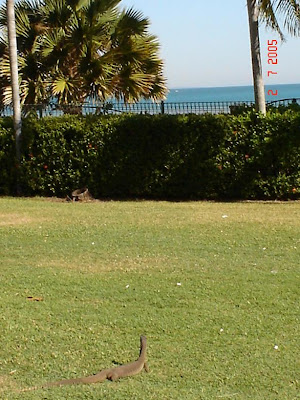 Australian Lizard in Darwin, Australia
Australian Lizard in Darwin, AustraliaAustralia has more lizards than any other part of the world. There is a huge variety of them. They range in size from the tiny Grey's Skink which is only 25 mm long, to the impressive Perentie, which can grow to over two meters.

My New Found Friend in Australia. He is just running around freely enjoying his beautiful day in Darwin Australia. I was a little nervous..O.K. very nervous. He is endangered so no one could play with him. He also like to swim in the hotel's pool. One time I was swimming and he decided to jump in the pool. So I jumped out and started running :)
 Yes, this pool later on the lizard is enjoying himself like a little Australian Prince :)
Yes, this pool later on the lizard is enjoying himself like a little Australian Prince :) Darwin, Australia
Darwin, Australia
Darwin, Australia is at the ‘Top End’, as the northern half of the Northern Territory of Australia is known. Darwin is a place of sunshine, beaches and hectic nightlife. Darwin has a tropical climate, and therefore no summer and winter, but instead a wet season from November until April and a dry season from May until October which is the busy time for Darwin tourism. Darwin attractions include museums, parks, art galleries, beaches and historic buildings. Darwin is a base for the Kakadu and Litchfield national parks.
Latitude: -12.43 (12°25'48"S)
Longitude: +130.85 (130°51'00"E)
Time zone: UTC+9:30 hours
Local time: 20:38:13
Country: Australia
Continent: Oceania
Sub-region: Australia and New Zealand
From Darwin To Adelaide, The Length Of Australia, 3010 Kilometres, Without Fuel!
ScienceDaily (Oct. 20, 2003) — On October 19, 30 cars will be jostling for position at the start of the 7th World Solar Challenge in Darwin, Australia. After winning in 2001 with Nuna I, the Nuon Solar Team, from the Netherlands, will be bidding to retain their title. The strong team of twelve from Delft University of Technology and Erasmus University Rotterdam are determined to beat the world record and try to average 100 km/h, compared to 91.81 km/h in 2001. Nuna II uses advanced space technology, provided to the team through ESA’s Technology Transfer Programme, enabling the car to reach a theoretical top speed of over 170 km/h.
ref: http://www.sciencedaily.com/releases/2003/10/031020054637.htm
See also:
Matter & Energy
Reference
The aerodynamically optimised outer shell consists of space-age reinforced plastics to keep it light and strong. The main body is made from reinforced carbon fibre and aramide, a material used in satellites, but nowadays also in high-performance equipment such as bulletproof vests.
The car’s shell is covered with the best triple-junction gallium arsenide solar cells, developed for satellites. The same cells are being tested on the SMART-1 satellite launched to the Moon on 28 September this year. Nuna II also carries Maximum Power Point Trackers, small devices that guarantee an optimal balance between power from the battery and the solar cells, even in less favourable situations like shade and cloud.
"Will they win? I am sure they have a great chance," says Wubbo Ockels, the first Dutch astronaut and today a professor at Delft University. "They have worked hard and with great dedication."
In pursuit of their goal, the student team have collected an impressive line-up of supporters. ESA has provided them not only with engineering support through its Technology Transfer Programme, but with general support from its Education Office. Dutch energy company Nuon is the main sponsor.

Driver Sten Swanenberg speeds at 120 km/h over the Stuart Highway in Australia. Nuna II took the lead on the first day of the World Solar Challenge 2003.
Credits: ESA / Alpha Centauri Nuon Solar Racing Team
Adapted from materials provided by European Space Agency.

Shopping Spree Downtown, Darwin.

Very Nice Peaceful Town. A Breath of Fresh air.






